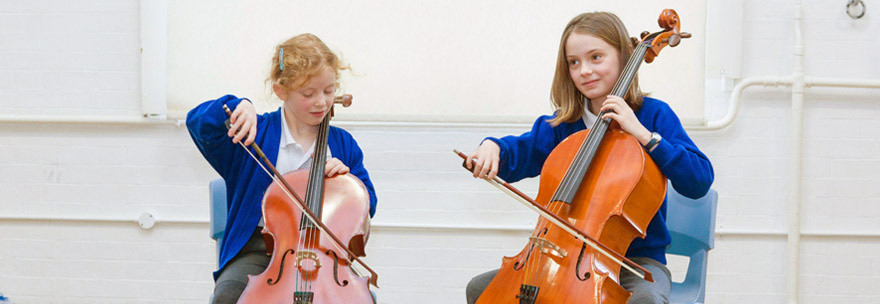ทักษะเสริม หรือ Supporting Tests เป็นส่วนหนึ่งของการสอบเกรดของทรินิตี้ โดยสำหรับระดับเกรด Initial - เกรด 5 จะต้องเลือกสอบ 2 หัวข้อ ส่วนในระดับเกรด 6 - เกรด 8 จะมีการขังคับทำ Sight Reading (ทักษะการอ่านโน้ต) และผู้สอบจะสามารถเลือกทำข้อสอบอีก 1 หัวข้อ โดยเลือกระหว่าง Aural Test (ทักษะการฟัง) หรือ Improvisation (การด้นสด)
Sight Reading (การอ่านโน้ต)
สำหรับนักดนตรี ทักษะการอ่านโน้ตถือเป็นสิ่งที่สำคัญมาก เพราะนอกจากจะทำให้เราเรียนรู้บทเพลงได้เร็วแล้ว ยังทำให้เราอ่านโน้ตได้แม่นยำถูกต้องตั้งแต่แรก ตัดปัญหาการอ่านโน้ตผิดซึ่งจะแก้ไขได้ยากหลังฝึกซ้อมเพลงไปแล้ว สำหรับนักดนตรีมืออาชีพการอ่านโน้ตได้เร็วถือเป็นทักษะที่สำคัญอย่างยิ่ง โดยเฉพาะเมื่อต้องเล่นรวมวงหรือซ้อมร่วมกันกับผู้อื่น ส่วนนักดนตรีมือสมัครเล่น จะได้ประโยชน์จากทักษะการอ่านในการฝึกหัดเพลงใหม่ ๆ ด้วยตนเอง
การสอบ
ในห้องสอบ ผู้สอบจะได้รับโน้ตเพลงที่ไม่เคยเห็นมาก่อน และมีเวลา 30 วินาทีเพื่อเตรียมตัว (สามารถทดลองซ้อมกับเครื่องดนตรีได้) เมื่อหมดเวลา ให้เริ่มบรรเลงตั้งแต่ต้นจนจบ โดยไม่ควรกลับไปแก้หรือเล่นซ้ำ ระดับความยากของโน้ตเพลงจะประมาณ 2 เกรดก่อนเกรดที่กำลังสอบ เช่น หากสอบเกรด 4 ระดับความยากชองข้อสอบจะประมาณเท่ากับเพลงเกรด 2 เป็นต้น
การฝึกฝน:
ทักษะการอ่านโน้ตคล้ายกับการอ่านหนังสือ โดยจะสามารถจะพัฒนาได้จากการฝึกฝนอย่างต่อเนื่อง เมื่อฝึกอ่านซ้ำ ๆ ก็จะทำให้อ่านโน้ตได้รวดเร็วและคล่องแคล่วขึ้น จนกระทั่งสามารถบรรเลงเพลงอย่างคร่าว ๆ ได้ทันทีเมื่อเห็นตัวโน้ต สิ่งที่สำคัญสำหรับการ Sight Reading ไม่ใช่การอ่านโน้ตถูกต้องทุกตัว แต่เป็นความสามารถในการทำให้บทเพลงดำเนินต่อไปโดยไม่หยุดหรือสะดุด
Aural (การฟัง)
การฟังเป็นทักษะที่สำคัญ โดยจุดประสงค์ของการพัฒนาทักษะการฟังนั้นเพื่อทำให้สามารถเข้าใจและวิเคราะห์องค์ประกอบทางดนตรีต่าง ๆ ได้อย่างถูกต้องโดยไม่ต้องเห็นตัวโน้ต การฟังจะเริ่มตั้งแต่ทักษะง่าย ๆ อาทิ บอกความสูงต่ำของตัวโน้ต พัฒนาไปสู่ทักษะระดับกลาง เช่นการบอกขั้นคู่เสียง บอก cadence (คอร์ดจบประโยคเพลง) ไปจนถึงการวิเคราะห์ สไตล์ การเปลี่ยนคีย์ และองค์ประกอบทางดนตรีได้ในระดับสูง
การสอบ
อาจารย์ผู้สอบจะบรรเลงบทเพลงสั้น ๆ ให้ฟังบนเปียโน จากนั้นผู้สอบจะต้องตอบคำถามเกี่ยวกับบทเพลงประมาณ 3-4 คำถาม โดยคำถามจะเป็นคำถามที่กำหนดตายตัวในแต่ละระดับเกรด เช่น ระดับ Initial ผู้สอบจะต้องตบมือเป็นจังหวะของเพลง ตอบว่าโน้ตตัวใดสูงกว่าหรือต่ำกว่า ฯลฯ ส่วนในระดับสูง เช่น เกรด 7 ผู้สอบจะต้องบอกอัตราจังหวะ ลักษณะ articulation และเลือกระบุองค์ประกอบของดนตรีสำหรับบทเพลงที่ได้ยิน อีก 2 ข้อ รวมทั้งตอบคำถามการเปลี่ยนคีย์ ฯลฯ เป็นต้น
การฝึกฝน:
อาจารย์ผู้สอนสามารถคัดเลือกทำนองเพลงสั้น ๆ มาบรรเลงให้นักเรียนฟัง แล้วถามคำถามที่เกี่ยวข้อง เช่น เล่นโน้ตให้ฟังแล้วให้ตอบว่าโน้ตสองตัวห่างกันกี่ขั้นคู่เสียง หรือ เล่นคอร์ดให้ฟังแล้วให้นักเรียนบอกชื่อคอร์ด เป็นต้น โดยควรเริ่มจากคำถามที่ง่ายและพัฒนาไปสู่งการฟังองค์ประกอบทางดนตรีที่ซับซ้อนต่อไป นอกจากนี้แล้ว นักเรียนยังควรหาโอกาสฟังเพลงในสไตล์ที่หลากหลาย เพื่อให้เข้าใจและคุ้นเคยกับเสียงของดนตรียุคต่าง ๆ
ตัวอย่างการสอบ
ตัวอย่างการสอบ Aural Test ระดับเกรด 1
Improvisation (การด้นสด)
คือการนำโจทย์มาเป็นวัตถุดิบตั้งต้น และบรรเลงดนตรีสดเป็นบทเพลงของตนเองจากวัตถุดิบเหล่านั้น
การสอบ
เลือกโจทย์ประเภทที่ต้องการ (สไตล์ดนตรี ทำนองสั้น ๆ หรือทางเดินคอร์ด) เมื่อได้รับโจทย์แล้ว อาจารย์ผู้สอบจะเล่นให้ฟัง 2 ครั้ง หลังจากนั้นมีเวลาเตรียมตัว 30 วินาที แล้วบรรเลงบทเพลงที่แต่งขึ้นตั้งแต่ต้นจนจบตามจำนวนห้องที่กำหนด
ผู้สอบสามารถเลือกโจทย์ได้ 3 แบบ ได้แก่
- Stylistic คือโจทย์แบบสไตล์ อาจารย์ผู้สอบจะเล่นท่อน intro สั้น ๆ เป็นแนวทางเพื่อกำหนดสไตล์ หลังจากนั้นจะเล่นพาร์ท accompaniment (บรรเลงประกอบ) ผู้สอบจะต้องแต่งทำนองและเล่นควบคู่ไปกับอาจารย์ผู้สอบในลักษณะการเล่น duet
- Motivic คือโจทย์จากโมทิฟ หรือแนวคิดทางดนตรี ผู้สอบจะได้เห็นทำนองสั้น ๆ ซึ่งสามารถนำไปพัฒนาในรูปแบบใดก็ได้ให้เป็นบทเพลงของตนเอง ในการด้นสดไม่จำเป็นต้องเล่นซ้ำทำนองให้เหมือนต้นฉบับ แต่ควรนำไอเดีย เช่น ตัวโน้ต หรือลักษณะจังหวะ ไปพัฒนาต่อเป็นบทเพลง
- Harmonic คือโจทย์จากทางเดินคอร์ด ผู้สอบจะได้รับกำหนดทางเดินคอร์ดประมาณ 4-8 ห้อง จากนั้นให้ด้นสดเพลงโดยใช้ทางเดินคอร์ดที่กำหนด
การฝึกฝน:
การด้นสดสามารถฝึกฝนได้โดยอาศัยความเข้าใจในเรื่องคีย์ คอร์ด และการทดลองด้วยตนเอง โดยอาจเริ่มจากการลองด้นสดโดยใช้โน้ตในคอร์ด และฝึกฝนแต่งทำนองให้ซับซ้อนยิ่งขึ้น นอกจากนี้แล้ว นักเรียนควรได้ฟังตัวอย่างสไตล์เพลงที่หลากหลาย อาจเริ่มด้วยการทดลองเลียนแบบและพัฒนาไปสู่การสร้างสรรค์ดนตรีของตนเองต่อไป
ตัวอย่างการสอบ
ตัวอย่างการสอบ Improvisation Test ระดับเกรด 2 เครื่องดนตรีวิโอล่า โจทย์ Stylistic Stimulus
Musical Knowledge (ความรู้ทางดนตรี)
ไม่ว่าเราจะเล่นเพลงอะไร เราควรมีความเข้าใจสิ่งต่าง ๆ เกี่ยวกับบทเพลง เช่น ผู้ประพันธ์คือใคร ชื่อเพลงหมายถึงอะไรและเกี่ยวข้องกับเพลงอย่างไร ตลอดจนสัญลักษณ์และเครื่องหมายทางดนตรีต่าง ๆ ที่ปรากฏในบทเพลง
การสอบ
อาจารย์ผู้สอบจะถามคำถามเกี่ยวกับเพลงสอบที่ผู้สอบเล่น อาทิ ความหมายของสัญลักษณ์ดนตรี และตัวโน้ต หรือให้อธิบายเกี่ยวกับเทคนิคที่ใช้ในบทเพลง โดยความยากง่ายของคำถามจะขึ้นกับแต่ละระดับเกรด ในการสอบผู้สอบสามารถเลือกได้ว่าให้อาจารย์ผู้สอบถามเกี่ยวกับเพลงใดก่อน จากนั้นอาจารย์ผู้สอบจะเลือกถามจากอีกหนึ่งเพลง ส่วนใหญ่แล้วอาจารย์ผู้สอบจะชี้ถามจากโน้ตเพลง ดังนั้นโน้ตเพลงที่ใช้จึงไม่่ควรมีข้อความหรือสัญลักษณ์ใดเขียนไว้ หากไม่มีโน้ตเพลงที่ปราศจากข้อความขีดเขียน ผู้สอบสามารถขอยืมหนังสือเล่มใหม่เข้าไปใช้ในการตอบคำถามได้จากศูนย์สอบ
การฝึกฝน:
ผู้สอบควรศึกษาและทำความเข้าใจตัวโน้ตและสัญลักษณ์ต่าง ๆ ที่ปรากฏในเพลงสอบที่เลือกเล่นอย่างครบถ้วน นอกจากนี้แล้ว สำหรับระดับสูงขึ้นไปยังควรมีความเข้าใจทางทฤษฎีดนตรี อาทิ ความเข้าใจเรื่องคีย์ การเปลี่ยนคีย์ โครงสร้างเพลง ฯลฯ ตลอดจนประวัติศาสตร์ดนตรีเบื้องต้นที่เกี่ยวข้องกับบทเพลง อาทิ ยุคสมัย สไตล์และผู้ประพันธ์
Sight Reading
This test assesses candidates' ability to perform an unseen musical extract, at a level approximately two grades lower than the exam being taken.
In the exam:
Candidates are given 30 seconds to study the test before performing it, during which time they may practise any or all of it aloud. The examiner does not mark this preparation period.
Tips:
Examples of sight reading tests may be found in Trinity's Sound at Sight series. Paremeters of the test can be found in the releavant syllabus.
Aural
This test supports the development of candidates' abilities in the field of muscial perception by assessing thier responses to carefully graded questions.
In the exam:
Questions are based on a single musical example, performed at the piano by the examiner. Details of the questions can be found in the syllabus.
Tips:
Practice tests can be found in Trinity's Aural Tests from 2017 books.
Example video:
Aural Test Grade 1
Improvisation
This test assesses candidates' ability to improvise fluently, coherently and creatively in response to a musical stimulus.
In the exam:
Candidates must choose a stimulus fromt he following options, indicating their choice of stimulus on the appointment form:
- Stylistic: The stylistic stimulus requires candidates to improvise over a notated piano part played by the examiner. Candidates are given a stimulus which includes the notated piano part and chord symbols. The stimulus begins with a two-bar introduction played by the examiner alone, followed by a further section over which candidates must improvise for a specified number of repeats. In the exam, the examiner plays the stimulus twice for candidates’ reference, without repeats. Candidates are then given 30 seconds’ preparation time, during which they may prepare for their improvisation aloud if they wish. The test then follows. The examiner then plays the stimulus again, and candidates join after the introduction, improvising for the specified number of repeats. Candidates should aim to improvise in a way that complements the musical idiom of the stimulus.
- Motivic: The motivic stimulus requires candidates to improvise unaccompanied in response to a short melodic fragment. Candidates are given a notated melodic fragment which the examiner plays twice on the piano for candidates’ reference (candidates are not required to play this back). Candidates are then given 30 seconds’ preparation time, during which they may prepare for their improvisation aloud if they wish. The test then follows. Candidates should aim to improvise within the specified duration range and may begin by quoting the stimulus directly, developing their improvisation from there. However, candidates are not required to quote the stimulus directly, and may instead develop their improvisation from ideas taken from the stimulus such as a small group of notes or an interval.
- Harmonic: The harmonic stimulus requires candidates to improvise unaccompanied in response to a chord sequence. Candidates are given a notated chord sequence, including chord symbols, which the examiner plays twice on the piano for candidates’ reference. Candidates are then given 30 seconds’ preparation time, during which they may prepare for their improvisation aloud if they wish. The test then follows. Candidates should improvise for the specified number of repeats, following the chord sequence. Please note that this test is always unaccompanied and the examiner will not provide a piano accompaniment for melodic instruments.
Example video:
Improvisation Test for Viola Grade 2, stylistic stimulus
Musical Knowledge (Initial - Grade 5 only)
This test assesses candidates’ understanding of the pieces being performed, as well as their knowledge of notation and their instrument. It does this by assessing their responses to carefully graded questions based on candidates’ three chosen pieces.
In the exam:
In the exam, candidates are invited to choose which piece they would like to be asked about first. The examiner then chooses a second piece for the remaining questions. Candidates’ scores should be free of annotations which might aid their responses. The examiner usually points to the relevant part of the score when asking questions. American terms (eighth note, half note, etc) may be used as an alternative to English terms (quaver, minim, etc).
Tips:
Test parameters and sample questions can be found in the relevant syllabus.


